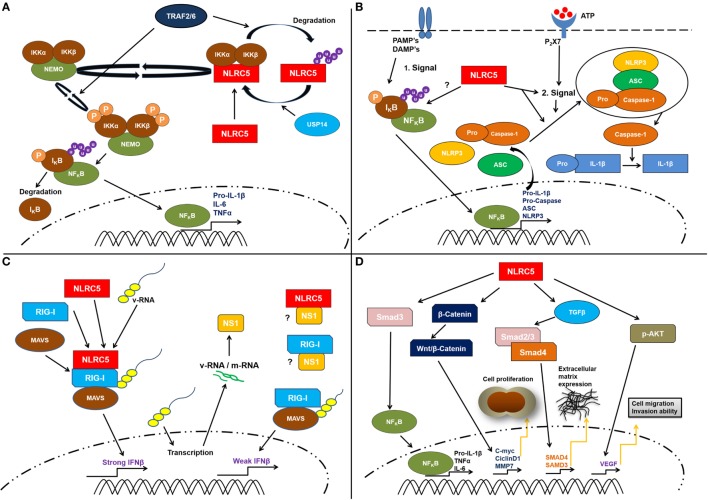Figure 2.
Schematic representation of the proposed cellular functions of cellular NLRC5. (A) Several studies suggest a contribution of NLRC5 to the nuclear factor kappa B (NF-κB) pathway. This might involve specific ubiquitination of NLRC5. A direct interaction between the IKKα/β and NLRC5 resulting in IKKα/β, which is unable to bind to NEMO (IKKγ) as well as reduced autophosphorylation and kinase activity was reported. Following lipopolysaccharide treatment, the TNF receptor-associated factors 2/6 (TRAF2/6) mediate NLRC5 ubiquitination. This leads to the degradation of NLRC5 that consequently frees IKKα/β complex and activates NF-κB pathway. (B) Possible role of NLRC5 in controlling inflammasome activation. The molecular mechanisms how this is achieved remains elusive. NLRC5 might affect priming by the regulation of NF-κB responses or might directly interfere with inflammasome activation. However, available data suggest that NLRC5 is more likely involved in the complex forming step of the inflammasome activation. (C) In antiviral responses, some studies suggest that NLRC5 interacts with retinoic acid-inducible gene I (RIG-I) and MAVS and might be able to enhance type I interferon responses. However, also contradicting data, suggesting a role of NLRC5 I inhibiting type I interferon responses has been presented. Several studies showed that in the absence of NLRC5, the IFNβ response is significantly weaker compared to the level observed when NLRC5 interacts with RIG-I and MAVS. (D) Finally, recent works suggest that NLRC5 can be linked to tumorigeneses via multiple pathways, such as β-catenin, TGF-β, and Akt, thereby resulting in changed cell proliferation and extracellular matrix deposition. However, these functions await validation at present. It should be mentioned that most of the depicted functions await further clarification (see main text for discussion).

